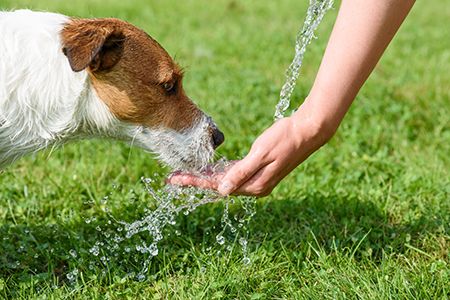When sidewalks sizzle: Understanding the dangers of heat stroke in pets
Fun in the sun can mean serious problems for overheated dogs. Help your clients know what to watch for and how to help when the pet is in trouble.
alexei_tm / stock.adobe.com

Well, it's that time of year again-backyard barbecues, beach days, fun in the sun. Those of us in the veterinary profession can only think, “Oh boy, heat stroke season.”
During the hotter summer months, the number of heat stroke cases increases dramatically. As is usually the case, brachycephalic dogs are at an increased risk compared with other breeds; however, that doesn't mean other dogs don't get heat stroke. Here are some warning signs that a pet is in danger of heat stroke:
- Excessive salivation
- Panting
- Inability to get comfortable
- Bright-red-colored tongue and gums
- Rectal temperature of 105 or more
- Lack of urine production
- Bloody diarrhea
What should pet owners do if they think their dog is in danger of or suffering from heat stroke? Get it out of the heat! If the pet is outside, it should be moved to a shaded area and offered water to drink. Cool water can also be used to wet down the pet's entire body. Fur is a great insulator and holds body heat in; wetting the pet down allows the body to cool as the water evaporates. This simulates sweating, which dogs can do only minimally from the pads of their feet. Ice water, ice packs and alcohol are not good choices as they can cause vasoconstriction, and any shivering will drive the body temperature back up.
A fan can also be used to blow lightly on the dog. The goal is to slowly lower the body temperature to about 103.4, then stop actively cooling. The dog's temperature may continue to drop, and that's OK. Avoid placing wet towels on the pet as these will create an insulating air barrier around the dog and hold heat in.
Heat stroke can be fatal if left untreated. Encourage your clients to seek veterinary care immediately if they're concerned that their pet may be suffering from heat stroke. Heat stroke can cause:
- Organ failure
- Shock
- Cardiac arrest
- Blood clotting disorders
- Vomiting blood
- Bloody diarrhea
- Black, tarry stools
- Seizures
- Drunken gait
- Muscle tremors
- Fluid buildup in the brain
- Unconsciousness
- Death
Also, heat stroke doesn't occur just when it's hot outside. Any excessively high environmental temperature-such as occurs if a pet is enclosed in an unvented space like a car or grooming dryer cage-can also cause heat stroke. Other factors that can contribute to heat stroke include:
- Upper airway disease, such as brachycephalic airway syndrome
- Some poisonous compounds
- Excessive exercise
- Underlying disease
- Anesthesia complications.
Patient risk factors include:
- Previous history of heat-related disease
- Heat intolerance (it can take 60 days to acclimate to a new climate)
- Thick, heavy fur coat-such as those on huskies, Newfoundlands, cocker spaniels and golden retrievers-especially if the patient lives in a hot geographical location
- Brachycephalic breeds, i.e.: French or English bulldogs, Boston terriers, Brussels griffons, shih tzus and boxers, to name a few
- Obesity
- Age, especially pediatrics and geriatrics
- Hyperthyroidism
- Dehydration
In the veterinary hospital
Once clients bring their pet to the clinic, the veterinary team will examine the pet to ensure that its body temperature has normalized and stabilized. If not, the team should cool the patient appropriately. Diagnostics such as urinalysis, blood work, ultrasound and electrocardiogram may be called for to check for clotting disorders, organ damage or other internal problems. Should any of these complications have occurred, they will need to be treated immediately and aggressively. Hospitalization may be required to provide oxygen supplementation, fluids and medications. Depending on the severity of the heat stroke and the reason for its occurrence, surgery to correct breathing problems may be necessary. Intravenous feedings to provide nutrition and allow the organs time to recover may also be indicated.
How do we prevent heat stroke?
Instruct clients to be aware. Dogs that have already had a heat stroke episode are at a higher risk of recurrence. Teach dog owners how how to cool their pet properly. Instruct them to avoid taking their pets out during the hottest part of the day or leaving them in a spot that may become too hot, such as a sun room, garage or car. And, of course, water needs to be continuously accessible. Clients who must be outside for an extended period should provide shade for their dog.
Remember, if they feel hot, their dogs feel hotter.
Reneé LaCorte, LVT, VTS (ECC), is a critical care and emergency department technician with BluePearl Veterinary Partners in New York City. She is a RECOVER certified CPR instructor.